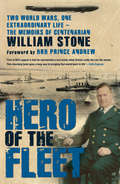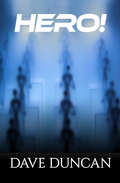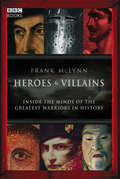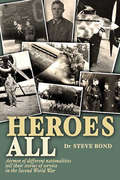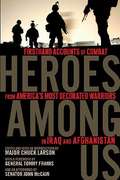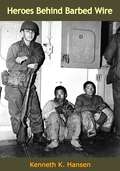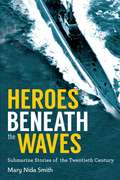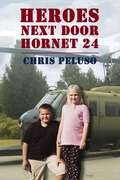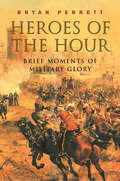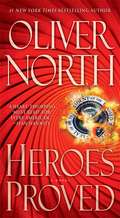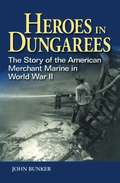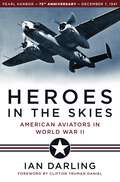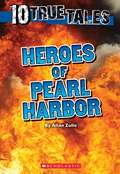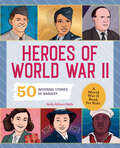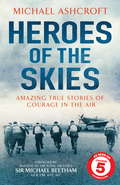- Table View
- List View
Hero of the Fleet: Two World Wars, One Extraordinary Life - The Memoirs of Centenarian William Stone
by William StoneWilliam Stone died on 10 January 2009 aged 108. He received a hero's funeral. Born in rural Devon, he joined the navy during the First World War, travelled the globe just before the British Empire's light began to fade and saw action in some of the most significant sea battles of the Second World War. Afterwards, he returned to Devon to run a barber's shop, an altogether more peaceable existence.As time passed, he became one of a dwindling number of men still alive who had served in the Great War. This meant that for some of the most momentous anniversaries clocked up recently - including the 90th anniversary of the end of the First World War - William was a guest of honour. This autobiography bridges two wars and encompasses the remarkable episodes and adventures. It was an ordinary life lived in extraordinary times. He died at a time when the navy is attempting to embrace new ships that bear scant resemblance to those that William knew and face the challenges of a world that shrinks with every bold technological advance. His was a different kind of boldness. This is his astonishing story.
Hero on a Bicycle
by Shirley HughesItaly, 1944: Florence is occupied by Nazi forces. The Italian resistance movement has not given up hope, though -- and neither have thirteen-year- old Paolo and his sister, Costanza. As their mother is pressured into harboring escaping POWs, Paolo and Costanza each find a part to play in opposing the German forces. Both are desperate to fight the occupation, but what can two siblings -- with only a bicycle to help them -- do against a whole army? Middle-grade fans of history and adventure will be riveted by the action and the vividly evoked tension of World War II.
Hero or Coward: Pressures Facing the Soldier in Battle
by Elmar DinterElmar Dinter addresses the question of why some men fight well in war and others do not. He examines the factors and draws conclusions involving recommendations for new methods of personnel selection and new tactics, training and military education.
Hero!
by Dave DuncanA spacefaring military adventure of one man&’s meteoric rise through the ranks from &“a great world-builder&” and award-winning author (SFReview). Space opera at its finest and most action‑filled, from the bestselling author of fantasy quests, epic tales, and swashbuckling adventures. Vaun, born a peasant in the stinking mud flats of Ult, a thriving colony planet, claws his way to survival and fame by becoming the toughest young officer in the Space Patrol. A veteran of the brutal training academy, he seizes opportunities as they arise, leading the first ship out against a surprise attack by the mysterious Brotherhood. He returns to a hero&’s welcome as the Brotherhood ship falls to the surface of his home planet in shattered pieces. The Brotherhood is elsewhere unstoppable, though, as neighboring planets, one by one, fall silent, conquered. And then, the Patrol detects a huge spacecraft launched from one of the now‑silent worlds and headed for Ult. Facing a challenge greater than he can truly hope to overcome, Vaun nonetheless sets out to save Ult for a second time.
Hero's Homecoming
by Rebecca CrowleySix months ago, being snowed in at Christmas with the amazing woman he met on R & R at Fort Riley would have been a dream come true, yet now, as a blizzard swirls outside Beth Tate's house, Captain Chris Walker knows he shouldn't be there. Blinded in combat and emotionally scarred, he never wanted Beth to know the man he's become-but stranded by the storm, he had no one else to call.Hurt and bewildered when Chris abruptly ended his faithful contact from Afghanistan, Beth tried to put him and their whirlwind romance out of her mind and prepared for a quiet holiday alone-until the phone rang. Now that he's here, she's more confused than ever, torn between love for the man she once knew and anger at the one who broke her heart.A life with Beth was everything Chris wanted, but the wounds of battle are nothing compared to the agony of heartbreak. It will take more than mistletoe, but perhaps this holiday season Chris will find his way home.33,000 words
Heroes & Villains: Inside the minds of the greatest warriors in history
by Frank McLynnIn the history of warfare, an elite group of men have attained almost legendary status through their courage, ambition and unrivalled military genius. But many of these same men possessed deep personal character flaws. In Heroes & Villains, acclaimed historian Frank McLynn focuses on six of the most powerful and magnetic leaders of all time: Spartacus, Attila the Hun, Richard the Lionheart, Cortés, Tokugawa Ieyasu and Napoleon. How did these mortal men rise to positions of seemingly invincible power? What were the motives, the personal strengths and often weaknesses that drove them to achieve what no one else dared? In six powerful portraits, McLynn brilliantly evokes the critical moments when each of these warriors proved themselves in battle, changing their own lives, the destiny of their people and, in some cases, the history of the world. We discover what drove Spartacus to take on the might of Rome against seemingly impossible odds, and how the young Napoleon rose to power in dramatic fashion at the Siege of Toulon. Heroes & Villains is more than a collection of individual biographies. By examining the complex psychologies of these extraordinary men, McLynn builds up a convincing profile of the ultimate warrior. Accompanying a major BBC television series, this brilliant book takes us into the minds of the greatest warriors in history.
Heroes All: Airmen of Different Nationalities Tell Their Stories of Service in the Second World War
by Steve BondThis WWII history shares the personal stories of frontline airmen from all sides of the conflict gathered through original interviews. Aviation historian Steve Bond has spent years interviewing veterans of World War II. He recorded the stories of former airmen and crewmembers who shared the same pieces of sky at the same time. The project brought together British and German, German and Russian, British and Italian, American and German—sometimes literally. In Heroes All, Bond presents the stories of these veterans—some of whom are household names—with annotations and overviews providing historical context. This is not a book about the rights and wrongs of war, nor the strategies of the military commanders. It is about the experiences and feelings of those on the front line. This volume includes stories and recollections from veterans of the Air Transport Auxiliary, British Army, Fleet Air Arm, Italian air force, Luftwaffe, Royal Air Force, Royal Canadian Air Force and Navy, Soviet air force, US Army, US Army Air Force, US Navy, and other groupings.
Heroes Among Us
by John S. Mccain Major Chuck Larson General Tommy FranksMore than one million Americans have served in Iraq and Afghanistan, but fewer than 500 from this group have earned a Silver Star, Navy Cross, Air Force Cross, Distinguished Service Cross, or the Medal of Honor. These Americans have demonstrated extraordinary courage under fire?in the worst of circumstances. They come from all branches of the military. They also come from all over the country and all walks of life, representing the entire spectrum of races and creeds. But what unites them are their deeds of consummate bravery, beyond the call of duty. Heroes Among Us tells these extraordinary true stories of valor, honor and sacrifice.
Heroes Behind Barbed Wire
by Kenneth K. HansenBehind barbed wire in Korea, 88,000 heroic Chinese and North Korean prisoners of war wrote an unforgettable account of their disillusionment with communism. This is the simple and moving story of their resolute decision to remain on freedom’s side of the Bamboo Curtain, rather than accept repatriation to their communist homelands, vividly recounted here by a first-hand observer, the former Chief of Psychological Warfare of the Far East Command.The story begins before the Korean armistice, in the prison compounds maintained by the United Nations Command on Koje Island. Here, humane and thoughtful treatment proved a more potent weapon than the communists’ brainwashing methods. The prisoners were carefully screened; only those who declared they would forcibly resist repatriation were admitted to the non-communist camps. Inside the camps, even though behind barbed wire, these men found a greater freedom of opportunity than they had been allowed in their communist homelands. They learned to read and write, studied agriculture and learned useful trades; and enjoy sports and recreation.Then, from Oct. to Dec. 1953, under the terms of the armistice, the anti-communist prisoners faced a crucial test of their determination. In a demilitarized zone near Panmunjom they were individually interviewed and subjected to “explanations” by communist officials regarding their final choice. There is deep tragedy and high comedy in the encounters at Panmunjom: tragedy in the threats made by the communists against the men and their families; comedy in the ingenious methods the prisoners devised to turn the tables on their interviewers during these grotesque propaganda sessions.The outcome? Only three percent of the total number of prisoners interviewed chose to return to a life under communist rule. Here was a disastrous loss of face for the communist world, and a sweeping victory for the cause of individual freedom…
Heroes Beneath the Waves: Submarine Stories of the Twentieth Century
by Mary SmithThe unbelievable stories of the heroic men who sailed under the sea. In Heroes Beneath the Waves, many brave men who rode submarines to great depths and across the oceans into unknown territory share their experiences, fears, and thoughts. They allow us to travel back in time through their memories. Trained for years to keep silent--for "loose lips sink ships”--many still believe what they know to be classified and refuse to disclose even the minutest of recollections. Others, however, want to leave a legacy of reminiscences for people to learn and live by--to know that freedom is not free. Some stories will never be told. Held within the secret confines of their souls, these deep sea veterans block them out for self-perseverance. Yet, there are others who will never escape their own minds; they relive their underwater experiences over and over with eyes open or shut. Heroes Beneath the Waves is about teenage boys who left farms, small towns, and inner cities to defend the United States and democracy worldwide. Signing up for United States Navy submarine duty was an adventure of a lifetime during the early 1940s. Dreams of torpedoing Japanese and German ships and subs consumed their thoughts. Those who returned home as young men were older and wiser. Heroes Beneath the Waves was written to honor these men--gallant heroes--who served and are serving today on submarines. Skyhorse Publishing, as well as our Arcade imprint, are proud to publish a broad range of books for readers interested in history--books about World War II, the Third Reich, Hitler and his henchmen, the JFK assassination, conspiracies, the American Civil War, the American Revolution, gladiators, Vikings, ancient Rome, medieval times, the old West, and much more. While not every title we publish becomes a New York Times bestseller or a national bestseller, we are committed to books on subjects that are sometimes overlooked and to authors whose work might not otherwise find a home.
Heroes Don't Run
by Harry Mazer"I wanted to serve, to be a part of this thing my father had given his life for. I didn't want the war to end, and all I'd be able to say was, No I didn't serve, I was right here the whole war, safe in Bakersfield." Adam Pelko witnessed the Japanese attack on Pearl Harbor that killed his father, a lieutenant on the USS Arizona. Even though Adam is underage, he defies his mother's wishes and enlists in the Marines. sent first to boot camp, then to Okinawa, he experiences the stark reality of war firsthand -- the camaraderie and the glory as well as the grueling regime, the paralyzing fear, and death. And at every turn, Adam must confront memories of his father. In the concluding volume of his World War II trilogy, Harry Mazer masterfully illustrates Adam's journey as he navigates brutal circumstances that no boy should know.
Heroes Next Door: Hornet 24
by Chris PelusoWritten to help address the dearth of age appropriate material focusing on the Vietnam conflict, Heroes Next Door – Hornet 24 gives the middle school and young adult reader a window into the lives of helicopter pilots during that conflict. The book is written with attention to detail, the reader experiences basic training, flight school, and twelve months of life, service, and sacrifice in Vietnam as told by a veteran who lives next door. Matt and Ellie are growing up in an average suburban area, when their next-door shows up with an olive-drab painted Army helicopter. The machinery sparks immediate interest and serves as a conduit to relationship building between the two children and their neighbor, Mr. Ed. Spread over nearly two years the siblings help restore the vintage aircraft and gradually, Mr. Ed shares stories of his training and experiences during the 1960s. Stories from Basic Training gives the reader a sense of the discipline and focus required. Flight training introduces the reader to some of the principles of helicopter flight and performance. Readers travel the globe, landing in Southeast Asia just after the Tet Offensive. The risk, fears, apprehensions, and personal development that come with such a deployment, along with the emotional growth, team building, and camaraderie weave into a series of combat action sequences. The reader is left with a basic understanding of the history of the conflict (thru late 1969), how U.S. and South Vietnamese troops engaged and searched for the communist forces, and how helicopters provided maneuverability and flexibility to the U.S. forces. Along the way, the reader is shown life in a large Army camp, Saigon, and the risks associated with assignment to Vietnam. Heroes Next Door-Hornet 24 also shows some of the lighter side of the conflict, rest and rehab in Bangkok, recreation in camp, team building, and a few current events. It also takes a brief look at the anti-war movement and how it affected the soldiers who were doing their duty. Heroes Next Door -Hornet 24 is a unique book that reveals the humanity and the horrors of the Vietnam War in a manner that is appropriate for younger audiences. With attention to historical accuracy and touching respect for the men and women of the Vietnam War, this book is a must-have companion for any young reader looking for real-life heroes.
Heroes Of The Hour
by Bryan PerrettThirteen true tales of men who were briefly military heroes of their time, but have since been largely forgottenThis book looks back to the time when an individual could change the course of history in a single battle or engagement, and yet still be forgotten. Here are the stories of the men who were regarded as heroes at the time but have now been forgotten or eclipsed. Some were honourable men and some not, but the actions of all were larger than life and make for exciting reading. They were mostly professional soldiers; one, Lieutenant Walter Hamilton, was a VC who fought the Kabul mob to the death, and took 600 of the enemy with him. Another, Major General Lew Wallace, primarily a lawyer and politician, commanded a division at the Battle of Shiloh, but is remembered now only as the author of Ben Hur.
Heroes Of The Hour: Brief Moments In Military Glory
by Bryan PerrettThirteen true tales of men who were briefly military heroes of their time, but have since been largely forgottenThis book looks back to the time when an individual could change the course of history in a single battle or engagement, and yet still be forgotten. Here are the stories of the men who were regarded as heroes at the time but have now been forgotten or eclipsed. Some were honourable men and some not, but the actions of all were larger than life and make for exciting reading. They were mostly professional soldiers; one, Lieutenant Walter Hamilton, was a VC who fought the Kabul mob to the death, and took 600 of the enemy with him. Another, Major General Lew Wallace, primarily a lawyer and politician, commanded a division at the Battle of Shiloh, but is remembered now only as the author of Ben Hur.
Heroes Proved
by Oliver NorthA gripping, tightly crafted, action-packed thriller from the man President Ronald Reagan called "an American hero." #1 bestselling author Oliver North applies his extensive experience as a combat-decorated U.S. Marine and counterterrorism expert in this explosive novel of global intrigue, military action, and cutting-edge suspense. It's the year 2032, and the president claims America is now safe from terror. We're told Iranian nuclear weapons no longer menace our citizens. Leaders in Washington insist that United Nations treaties and innovative technologies can protect us and assure peace in our time. To save money, "Progressives," holding power in our capital, have cut the U.S. Armed Forces to the bone. But when the city of Houston is targeted by suicide bombers--and Dr. Martin Cohen, America's foremost physicist, is kidnapped--the brilliantly executed attack sends shock waves around the globe. The price of fuel skyrockets. With the U.S. economy on the brink of catastrophe, leaders in Washington look for a scapegoat--instead of our missing scientist. Enter Peter Newman, a highly decorated U.S. Marine war hero, veteran of multiple high-risk covert operations--and Naval Academy roommate of Dr. Marty Cohen. The precarious quest to find and rescue his friend puts the entire Newman family in lethal peril--and exposes the most ominous threat to the United States in our nation's history. Only someone who has actually "been there, done that" could write this book. Filled with heart-stopping action, authentic detail, and blistering tension, Heroes Proved is the most riveting work yet from national security expert, master novelist, and real-life war hero Oliver North.
Heroes and Cowards: The Social Face of War
by Matthew E. Kahn Dora L. CostaWhen are people willing to sacrifice for the common good? What are the benefits of friendship? How do communities deal with betrayal? And what are the costs and benefits of being in a diverse community? Using the life histories of more than forty thousand Civil War soldiers, Dora Costa and Matthew Kahn answer these questions and uncover the vivid stories, social influences, and crucial networks that influenced soldiers' lives both during and after the war. Drawing information from government documents, soldiers' journals, and one of the most extensive research projects about Union Army soldiers ever undertaken, Heroes and Cowards demonstrates the role that social capital plays in people's decisions. The makeup of various companies--whether soldiers were of the same ethnicity, age, and occupation--influenced whether soldiers remained loyal or whether they deserted. Costa and Kahn discuss how the soldiers benefited from friendships, what social factors allowed some to survive the POW camps while others died, and how punishments meted out for breaking codes of conduct affected men after the war. The book also examines the experience of African-American soldiers and makes important observations about how their comrades shaped their lives. Heroes and Cowards highlights the inherent tensions between the costs and benefits of community diversity, shedding light on how groups and societies behave and providing valuable lessons for the present day.
Heroes and Landmarks of British Aviation: From Airships to the Jet Age
by Richard Edwards Peter J. EdwardsHeroes and Landmarks of British Aviation tells the dramatic story of a world leading aviation industry, from the sweat and grease of the workshop, to the board rooms and government nationalisations that ultimately fashioned its destiny.The heroes are Britains most innovative aviation pioneers and their aircraft, the men and women who persevered to be the first into the air, to fly the fastest, the highest and the furthest. This broad and highly accessible books ranges from the first man to fly across the English Channel from England to France to the development of the Spitfire and from the disastrous R101 airship to the development of the jet engine and ultimately the worlds first supersonic airliner.Each chapter looks at a different aviation pioneer and the flying machines that they designed, their engineering landmarks, their triumphs in the air and on occasion their disasters too. The book explores the great air races that were won and lost, the government contracts and political short-sightedness that cut short the development of leading aircraft designs and many of the dramatic air raids and sea battles from the First World War to the Falklands and the Middle East.Many of the industrys most prominent names are profiled, including Ernest Willows, the Short brothers, Geoffrey de Havilland, Vincent Richmond, George White, Thomas Sopwith, Harry Hawker, RJ Mitchell, Herbert Smith, Charles Rolls, Henry Royce, Reginald Pierson, Alliott Verdon-Roe, Frederick Handley Page, Robert Watson-Watt, Robert Blackburn and Frank Whittle.Behind the personal stories are the histories of the aircraft companies that these pioneers created, from those that went bankrupt to those that lasted the test of time and have become indivisible from British aviation folklore, such names as Sopwith, Handley Page, Avro, Supermarine, Blackburn, Bristol, Fairey and Rolls-Royce. The book covers the mergers and acquisitions that led to the creation of two major aircraft manufacturers, Hawker Siddeley Group and the British Aircraft Corporation, and how barely two decades later, before the century was out, they were nationalised to form British Aerospace.
Heroes de Guerra
by Daniel Wrinn“Una aventura de la Segunda Guerra Mundial llena de acción. . . me sentí como si estuviera viendo una película ". - Opinión de un lector En lo profundo de la Blitzkrieg, un piloto desafortunado debe luchar para sobrevivir. Cuando el aspirante a piloto John Archer se ve atrapado en medio de la devastadora invasión nazi de Francia, rápidamente se da cuenta de que sus vacaciones podrían costarle la vida. Como un estadounidense arrastrado por una ola de refugiados que huyen del caos del avance alemán, en el fondo sabe que está muy por encima de él. Después de que un ataque de un bombardero en picado Stuka lo obliga a huir al bosque, Archer se topa con un conductor de ambulancia llamado Barney James. Juntos, traman un plan para escapar de la Blitzkrieg alemana y llegar a un lugar seguro. Pero no será tan simple. Una captura desafortunada llevará a Archer a descubrir información vital sobre los planes de los nazis, sabe que no tiene más remedio que escabullirse de las narices de su enemigo y contarles a los aliados lo que ha encontrado. Con nada más que su entrenamiento básico de piloto y la determinación de tener éxito, Archer necesitará más que un golpe de suerte para lograr el escape del siglo. Incluso si logra llegar detrás de las líneas aliadas, no estará a salvo: los nazis están avanzando. Combinando acción y aventuras clásicas con un fascinante e histórico escenario de la Segunda Guerra Mundial, el primer libro de la serie John Archer es ideal tanto para aficionados a la historia como para lectores ocasionales. Esta aventura llena de acción es perfecta para lectores adolescentes y adultos jóvenes.
Heroes in Dungarees
by John BunkerA World War II merchant seaman, John Bunker takes a thorough look at the American merchant marines' significant contributions to the war effort. There are plenty of fascinating facts about their extensive supply operations, but the focus of the book is on the men and their often-heroic actions. Bunker draws from his own experiences to describe the action at sea and also includes the personal stories of many other civilian participants. It is a engaging portrayal of the courage, bravery, and ingenuity demonstrated by these merchant seamen. All theaters of operation using U.S. merchant ships are covered, and in addition, Bunker provides information on events before the country entered the war when efforts were being made to build more ships and to recruit the men necessary to crew the huge fleet.
Heroes in the Skies: American Aviators in World War II
by Ian DarlingPublished to coincide with the 75th anniversary of the attack on Pearl Harbor, these gripping true stories capture the astonishing bravery of the fliers who helped win World War II. American pilots fought fierce and often deadly battles in every theater of war, and many overcame incredible obstacles to survive. Meet some of these courageous aviators, including George McGovern, who survived enemy fire that left 110 holes in his aircraft; George H. W. Bush, shot down in the Pacific; Jim Landis, a naval flyer stationed in Pearl Harbor who returned fire even after sustaining a bullet through his hand; Alex Jefferson, a Tuskegee airman shot down over France and taken prisoner; and Betty Blake, one of the little-known women pilots who aided the war effort. Clifton Truman Daniel, a grandson of President Truman, provides the foreword to this collection of carefully researched and vividly told profiles in courage that will transport you to the bullet-ridden, bomb-laden skies of the early 1940s.
Heroes of Coastal Command: The RAF's Maritime War 1939–1945
by Andrew D. BirdReal-life, action-packed, personal stories of valor from the history of the RAF&’s maritime arm during World War II. It took thirty minutes for one Coastal Command crew to sink two U-boats. The crew of Flying Officer Kenneth &“Kayo&” Moore in their 224 Squadron Liberator carried out this remarkable achievement on the evening of 7/8 June 1944. While patrolling the western end of the English Channel, Moore&’s crew first dispatched U-629, followed just under thirty minutes later by U-373. The story of this remarkable engagement is just one of many recounted by the author in Heroes of Coastal Command. Established in 1936, Coastal Command was the RAF&’s only maritime arm. Throughout the war, its crews worked tirelessly alongside the Royal Navy to keep Britain&’s vital sea lanes open. Together, they fought and won the Battle of the Atlantic, with RAF aircraft destroying 212 German U-Boats and sinking a significant tonnage of enemy warships and merchant vessels. Often working alone and unsupported, undertaking long patrols out over opens seas, Coastal Command bred a special kind of airman. Alongside individuals such as Kenneth Moore, there were Allan Trigg, Kenneth Campbell and John Cruickshank, all of whom were awarded the Victoria Cross; Norman Jackson-Smith, a Blenheim pilot who flew in the Battle of Britain; Jack Davenport, who flew his Hampden to Russia; John Watson, the sole survivor of a Short Sunderland which was lost during a rescue mission; and Ken Gatward, who flew a unique daylight mission over Paris to drop a Tricolore on the Arc de Triomphe. Theirs are just some of the many exciting stories revealed by the author.
Heroes of Pearl Harbor (Ten True Tales)
by Allan ZulloA massive bomb explosion destroys the battleship USS Arizona and pitches Cassin Young, captain of the nearby USS Vestal, overboard into a flaming oil slick. The dazed commander must find a way back to his ship and save her before she sinks too. <p><p> Julio DeCastro and Joe Bulgo can hear sailors trapped inside the capsized USS Oklahoma, which is rapidly filling with water. After toiling all day and all night with their pneumatic hammers, can the exhausted workers cut through the steel hull and save their comrades in time? <p> Despite suffering serious wounds, Chief Petty Officer John Finn continues to stand out in the open, firing his machine gun at a swarm of Japanese fighter planes while yelling to his fellow sailors, "No one attacks America and gets away with it!" <p> These and other real-life heroes risked their lives during the surprise attack on Pearl Harbor, which forced America into World War II. You will never forget their courageous true stories
Heroes of World War II: A World War II Book for Kids: 50 Inspiring Stories of Bravery (People and Events in History)
by Kelly Milner HallsAn introduction to the brave heroes of World War 2 for kids ages 8 to 12 Sometimes all it takes to make a difference is a single person willing to risk their life and take a stand. This inspiring collection of biographies explores the stories of some of the most amazing heroes of World War 2. From Anne Frank and Oskar Schindler to our forgotten African allies, these soldiers, spies, and freedom fighters helped change the world and save millions of lives. What will kids learn from their stories of selflessness and bravery? 50 incredible tales—Kids will learn about what happened in World War II through the eyes of the people who lived and fought during it. Powerful quotations—Help kids better understand who these people were and what they stood for with direct quotes included in each story. Learn more—Kids can find out even more about the heroes in this book thanks to suggestions for further reading at the end of each biography. Introduce kids to the incredible stories of heroic men and women in this standout among biography books.
Heroes of the Holocaust: True Stories of Rescues by Teens
by Allan Zullo Mara BovsunThe accounts are based exclusively on personal, lengthy interviews conducted with or about each person featured in this book. Using real names, dates, and places, the stories are written as factual and truthful versions of the heroes' recollections, although some of the dialogue has been re-created.
Heroes of the Skies
by Michael AshcroftSince the dawn of aerial combat in the First World War, the heroism of the men who put their lives at risk in the air has known no bounds. There were no more heroic airmen than the fighter pilots and bomber crews of the Second World War - men who sacrificed their own lives in order to save their crew or who, although in extreme pain, managed to get their aircraft home rather than risk becoming PoWs. In telling the stories of more than eighty such men, Heroes of the Skies paints a picture of aerial combat from the First World War right through to Afghanistan, and allows us to celebrate the extraordinary feats of our flying heroes.
